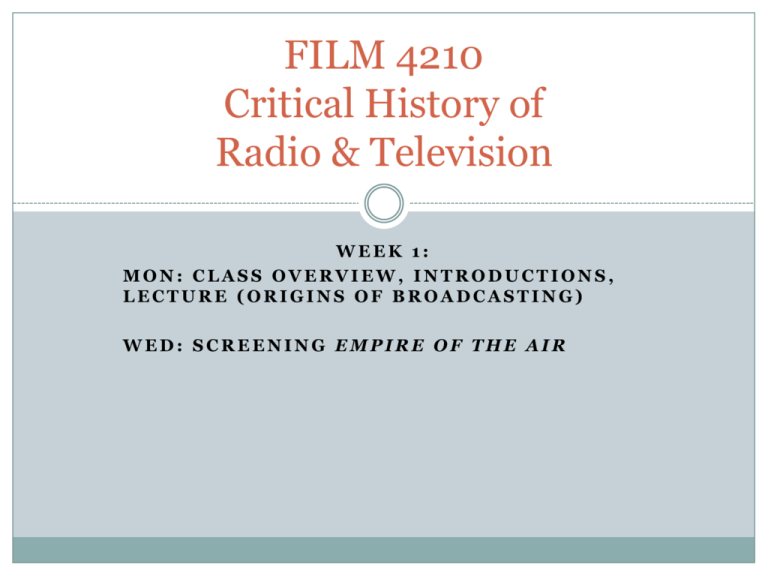RadioTV History Week 1
advertisement

FILM 4210 Critical History of Radio & Television WEEK 1: MON: CLASS OVERVIEW, INTRODUCTIONS, LECTURE (ORIGINS OF BROADCASTING) WED: SCREENING EMPIRE OF THE AIR EARLY VISIONS OF TELEVISION Punch – Du Maurier, 1879 predicted two way communication of sporting events. 1882 french artist, Robida predicted that women would use the “telephonoscope” to learn about consumer goods for the home and men would watch “girlie shows” and “battles” in the comfort of their living rooms. INNOVATORS GUGLIELMO MARCONI – - a “boy tinkerer” worked “outside the academy” - His mother, Annie Jameson Marconi, supported ambitions - drew from existing telegraph technologies and theories of “the ether” to develop wireless communication. - Key contributions the “antenna” which allowed for telegraphed messages using MORSE CODE to be transmitted through the air. – the “wireless” - Italians rejected his invention. Mrs. Marconi and the Jameson family connected him with British government. INNOVATORS GUGLIELMO MARCONI – - 1897 Marconi Company formed - 1899 the New York Herald invited Marconi to the U.S. to cover The America’s Cup Race using his “wireless” - 1899 “wireless” technology marketed to US Navy under the subsidiary American Marconi INNOVATORS Key reasons why US press supported Marconi’s wireless technology: - it could compete against the high priced Western Union telegraph and Bell Telephone monopolies. - Postal Service was slow and “antiquated” - Newspapers anticipating owning their own wireless stations - PROMOTED REASON: save lives, promote understanding, reduce loneliness and isolation, put long distance communication in the hands of the people. RESULT: Massive eruption of “wireless mania” and “boy amateur operators” INNOVATORS REGINALD AUBREY FESSENDEN-Canadian electrical engineer contracted to work on wireless experiments for US Dept of Agriculture - Formed National Electric Signaling Company and focused on wireless “voice” transmissions. - Coined the term “radio” - 1906 Christmas Eve ship wireless operators throughout the Atlantic Ocean and as far as the West Indies heard a woman sing “O Holy Night” and a man read the Christmas story passage from Luke 2:1-20 - United Fruit Company equipped their banana boats with radios - Fessenden’s company acquired by Westinghouse INNOVATORS LEE DE FOREST – - Further developed voice transmission with the use of the “audion tube” - Conducted several demonstrations using popular music, live readings of newspaper articles, and women’s suffrage speeches. [A precursor to commercial radio broadcast programming formats] - Conceptualized “broadcasting” rather than person-toperson or ship-to-shore communication. - “Broadcasting was thought to have “no commercial value” but the amateur operators embraced the news/entertainment program format INNOVATORS DAVID SARNOFF- Russian Jewish immigrant - Not an inventor or a scientist. As a young began working as a wireless operator for American Marconi. - By age 18 he was a manager at American Marconi. Is credited with reporting the sinking of the Titanic. - After WWI when the US Government forced American Marconi to transfer its interests Sarnoff went to work for Radio Corporation of America (RCA). - [RCA formed from United Fruit, AT&T, Westinghouse and American Marconi] - Later became President of RCA and debuted the first television public broadcast at the 1939 New York Worlds Fair REGULATION & OWNERSHIP - First 10 years of wireless were unregulated - Congress presented several bills. None passed. - Navy wanted total control over wireless - “amateur boys” lobbied Congress to keep airwaves free and in the hands of the people. - Collision of the Republic and the Florida led to the - 1910 Wireless Ship Act REGULATION & OWNERSHIP 1910 Wireless Ship Act - The Republic’s wireless helped save 1200 people. - Ships must be equipped with wireless if: - - they carry 50+ people -entering or exiting a US port Traveling 200 miles or more. REGULATION & OWNERSHIP Key reason for proposed regulation: - Interference on the airwaves. Overcrowding. - 1910 Wireless Ship Act created more overcrowding REGULATION & OWNERSHIP The Titanic Wireless Room Jack Phillips refuses to leave post - The California was less than 20 miles from Titanic but they’d shut down for the night. Wireless left unmanned. (1912) Titanic disaster led to: - Ship wireless must be manned and operational at all times. (two employees and auxiliary power). - Fines and jail time for erroneous reports - Ships required to respond to distress calls - The Radio Act of 1912 REGULATION & OWNERSHIP Radio Act of 1912 - All operators must be licensed - Stations adhere to assigned wave allocations - Amateurs (who passed license test) relegated to “short waves” - Fines for “malicious interference” - Strongest end of the spectrum given to the Navy - The government could take full control in a time of crisis/war. REGULATION & OWNERSHIP WWI - All amateurs required to leave the air and seal their equipment in - - a closed box for the duration of the War After War Navy tries once again to wrestle control of wireless from corporate interests Congress did not pass Navy owned wireless. (In part due to continued “boy amateur” protests). Instead required all radio to be US owned. Forced American Marconi to dissolve. Gov’t set up a shell corp called Radio Corporation of America and orchestrates collection of assets and stock sales to GE, Westinghouse, AT&T and United Fruit RCA would become the leader in international communication







